英语修辞学课程教学大纲2013版
- 格式:pdf
- 大小:188.58 KB
- 文档页数:14

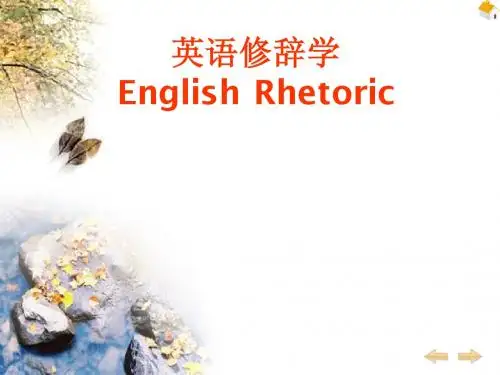
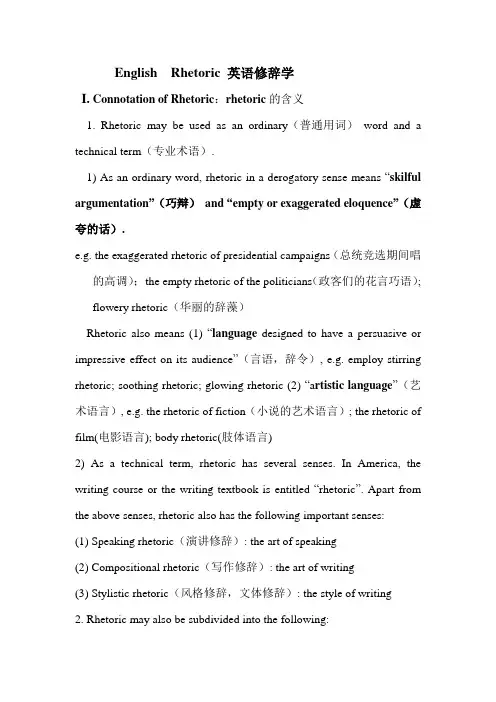
English Rhetoric 英语修辞学I. Connotation of Rhetoric:rhetoric的含义1. Rhetoric may be used as an ordinary(普通用词)word and a technical term(专业术语).1) As an ordinary word, rhetoric in a derogatory sense means “skilful argumentation”(巧辩)and “empty or exaggerated eloquence”(虚夸的话).e.g. the exaggerated rhetoric of presidential campaigns(总统竞选期间唱的高调);the empty rhetoric of the politicians(政客们的花言巧语);flowery rhetoric(华丽的辞藻)Rhetoric also means (1) “language designed to have a persuasive or impressive effect on its audience”(言语,辞令), e.g. employ stirring rhetoric; soothing rhetoric; glowing rhetoric (2) “a rtistic language”(艺术语言), e.g. the rhetoric of fiction(小说的艺术语言); the rhetoric of film(电影语言); body rhetoric(肢体语言)2) As a technical term, rhetoric has several senses. In America, the writing course or the writing textbook is entitled “rhetoric”. Apart from the above senses, rhetoric also has the following important senses:(1) Speaking rhetoric(演讲修辞): the art of speaking(2) Compositional rhetoric(写作修辞): the art of writing(3) Stylistic rhetoric(风格修辞,文体修辞): the style of writing2. Rhetoric may also be subdivided into the following:1) Lexical rhetoric(词汇修辞):the rhetorical law of choosing words and phrases2) Sentence rhetoric(句子修辞):the rhetorical law selecting sentence patterns3) Paragraph rhetoric(段落修辞):the rhetorical law of organizing paragraphs4) textual rhetoric(语篇修辞):the rhetorical law of organizing textsII. Definition of Rhetoric修辞学的定义What is rhetoric ?1.Origin of modern rhetoric: 现代修辞学的起源Rhetoric originated in “speaking”(说话). Aristotle(亚里士多得), in the 4th century BC, first defined rhetoric as the art of persuasion, equivalent to argumentation as people understand today. John Locke(约翰.洛克), English philosopher of the late 17th century, described rhetoric as “the science of oratory(演说术)” or “the art of speaking with propriety, elegance and force(修辞学是说话得体、优美和有力的艺术)”. All this explains why the word “rhetoric” means “speaking”in such European languages as Greek, Latin, French, Spanish and Italian. In the book Modern Rhetoric by American linguists Brooks(布鲁克斯)and Warren(沃伦)rhetoric is defined as “the art of using language effectively(修辞学是有效地使用语言的艺术)”.In the New Oxford Dictionary of English rhetoric is described as “the art of effective or persuasive speaking or writing, especially the exploitation of figures of speech or other compositional techniques(修辞学是有效或有说服力的演说或写作的艺术,特别是运用英语修辞格或其它写作的艺术)”.2.Rhetoric and Figures of Speech:Figures of speech are quite different from rhetoric, but they are important components in English rhetoric. In the New Oxford Dictionary of English, “figure of speech” is defined as “ a word or phrase used in a non-literal sense too add rhetorical force or interest to a spoken or written passage”(修辞格是用一个非字面意义的单词或短语使一段口头或笔头的文字增加修辞效果或兴趣). They refer to rhetorical devices(修辞手段), each of which has a fixed pattern, e.g. Simile is introduced by comparative words as, like, as if, as though, etc.; Like Simile, Metaphor refers to the comparison of two essentially unlike things which have one point of resemblance;Irony refers to the intended implication of which is the opposite of the literal sense of words; Oxymoron refers to the conjunction of two words or phrases which are incongruous or contradictory in sense so as to describe a person or thing; Pun; a play on words, sometimes on different senses of the same word and sometimes onthe similar sense or sound of different words; etc. These figures are employed in the following.He is as stupid as a goose. (=He is very stupid.)He has a heart of stone./ He has a heart like flint.(=He is unfeeling and stubborn.)He slept like a log / top. (=He slept very soundly.)They are birds of a feather. (=They are people of the same sort.) (Simile and metaphor are used of the comparison of two essentially unlike things which have one point of resemblance.) This hard-working boy seldom reads more than an hour per week. (If a boy seldom reads more than an hour per week, he must be very lazy, not hard-working.)(Irony refers to the intended implication being the opposite of the literal sense of words)He seems to be a clever fool. (=He seems to be a fool, but in fact he is very clever.)(Oxymoron refers to the conjunction of two words or phrases which are incongruous or contradictory in sense)Ask for me tomorrow and you shall find me a grave man.(grave: adj. serious; n. tomb The speaker stresses the latter.) (Pun refers to a play on words,sometimes on different senses of the same word and sometimes on the similar sense or sound ofdifferent words)3.The difference between rhetoric and grammar, phonetics,lexicolog y1)The difference between rhetoric and grammarRhetoric is different from grammar, but it is closely related to grammar and also based on grammar. To be grammatically correct is foundation to writing, but it is not enough. Basic rhetorical requirements must also be met. Francis Christensenn, an American French rhetorician, once said:Grammar maps out the possible(计划可能发生的事情);rhetoric narrows the possible down to the desirable and effective (使可能发生的事情变成很理想的事情或有效地事情).In the preface to the book A handbook of English Rhetoric Warren quoted a passage by a scholar:Grammar is the law of language, considered as language;rhetoric is the art of language, considered as thought.Grammar tells what is correct; rhetoric tells what is effective and pleasing.2)Rhetoric and phonetics, lexicologyRhetoric is quite different from phonetics and lexicology. Phonetics is about the study of speech sounds and their pronunciation;lexicology is about the study of the vocabulary of a language;grammar concerns the study or science of rules for forming words and combining them into sentences; whereas rhetoric is the art of speaking or writing so as to persuade people effectively.I II. The Object of the Study of Rhetoric(修辞学研究的内容)Rhetoric aims at studying all forms of culture, which may be forms of mass media or any cultural phenomenon, concrete or abstract. Modern rhetoric seems to include all forms of discourse ---- written or colloquial, even all forms of communication in symbols.(修辞学研究的对象是一切文化形式,它们可以是任何这样或那样、具体或抽象的文化现象。
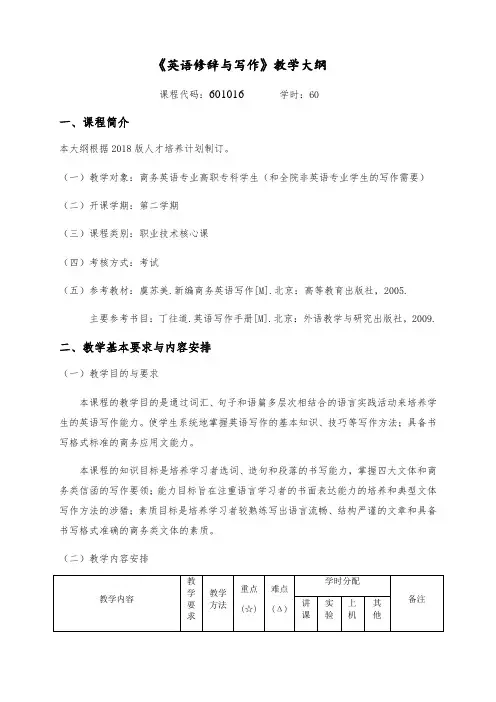
《英语修辞与写作》教学大纲课程代码:601016学时:60一、课程简介本大纲根据2018版人才培养计划制订。
(一)教学对象:商务英语专业高职专科学生(和全院非英语专业学生的写作需要)(二)开课学期:第二学期(三)课程类别:职业技术核心课(四)考核方式:考试(五)参考教材:虞苏美.新编商务英语写作[M].北京:高等教育出版社,2005.主要参考书目:丁往道.英语写作手册[M].北京:外语教学与研究出版社,2009.二、教学基本要求与内容安排(一)教学目的与要求本课程的教学目的是通过词汇、句子和语篇多层次相结合的语言实践活动来培养学生的英语写作能力。
使学生系统地掌握英语写作的基本知识、技巧等写作方法;具备书写格式标准的商务应用文能力。
本课程的知识目标是培养学习者选词、造句和段落的书写能力,掌握四大文体和商务类信函的写作要领;能力目标旨在注重语言学习者的书面表达能力的培养和典型文体写作方法的涉猎;素质目标是培养学习者较熟练写出语言流畅、结构严谨的文章和具备书写格式准确的商务类文体的素质。
(二)教学内容安排(教学要求:A—熟练掌握;B—掌握;C—了解)三、实训内容技能训练项目1:优秀作文的分析技能训练项目2:商务信函的写作技能训练项目3:基于中国优秀传统文化背景阅读的英文四大文体写作制订人(签字):李芙蓉审核人(签字):安徽交通职业技术学院学期授课计划( 2018 /2019学年第一学期)课程名称(全称)英语修辞与写作授课班级 18级学生 课程总学时 60 本课程计划学时 60任课教师 李芙蓉 制定日期 2018 年 9 月 教研室主任(签字)系部主任(签字)教务处主任(签字)教学大纲制定部门 安徽交通职业技术学院 教材全称(编者、出版单位、出版时间)《新编商务英语写作》第二册高等教育出版社主要教学参考书(名称、编者)《新编商务英语写作》第一册 虞苏美《英语写作手册》丁往道本学期教学周数15本课程每周学时数4本课程学期总时数60编制说明:本学期教学时数分配讲授 30 实验 习题课28学期授课计划( 2018 /2019学年第 1学期)教师姓名:李芙蓉课程:英语修辞与写作班级: 18级学生学期授课计划( 2018 /2019学年第 1学期)教师姓名:李芙蓉课程:英语修辞与写作班级: 18级学生学期授课计划( 2018 /2019学年第 1学期)教师姓名:李芙蓉课程:英语修辞与写作班级: 18级学生学期授课计划( 2018 /2019学年第 1学期)教师姓名:李芙蓉课程:英语修辞与写作班级: 18级学生。
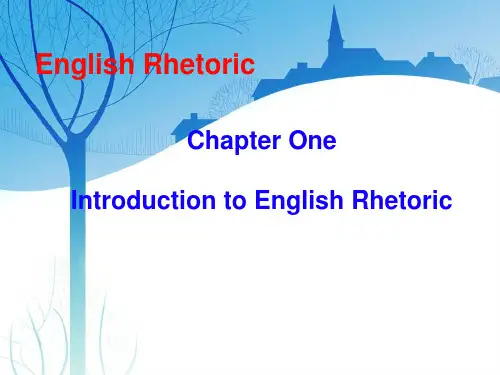
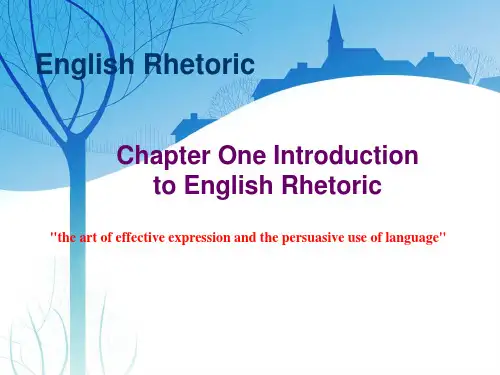
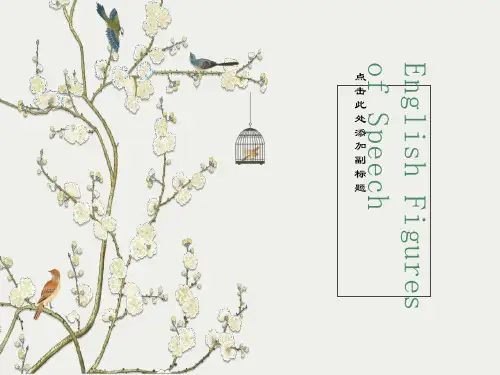

目录学院简介 (2)英语专业培养方案与教学计划 (3)英语专业主要课程教学大纲《基础英语》教学大纲 (6)《高级英语》教学大纲 (15)《英语听力》教学大纲 (18)《英语泛读》教学大纲 (19)《英语口语》教学大纲 (23)《英语语音》教学大纲 (28)《英语语法》教学大纲 (29)《基础英语写作》教学大纲 (31)《高级英语写作》教学大纲 (33)《英语测试》教学大纲 (35)《英美影视欣赏》教学大纲 (36)《英美报刊阅读》教学大纲 (37)《口译》教学大纲 (39)《翻译理论与实践》教学大纲 (41)《学术论文写作》教学大纲 (43)《英国文学选读》教学大纲 (44)《美国文学选读》教学大纲 (47)《英美文化》教学大纲 (49)《英语语言学概论》教学大纲 (50)《应用语言学》教学大纲 (52)《日语》教学大纲 (55)《法语》教学大纲 (57)学院简介外国语学院具有悠久的办学历史,其前身可溯源至1934年南京医科大学创建时便成立的外语教研室,主要承担全校的公共外语教学工作。
2000年,外语教研室更名为外语部,除进行公共外语教学外,于2003年设置了四年制本科英语专业,从而在专业建设方面取得了重要进展。
2006年,作为学校大力发展人文学科的重大举措之一,外国语学院正式成立,从而迎来了外语教学与科研发展的全新局面。
外国语学院目前有在编教职工49名,其中专任教师41名,教授、副教授8名;此外,学院还聘有兼职教授、副教授6名,外籍语言专家3名。
学院下设英语系、大学外语一部、大学外语二部、研究生外语部、英美文化研究所、外语培训中心、院行政办公室等教学、科研及行政机构,承担全校本科生、研究生公共外语教学及英语专业教学工作。
全院教师恪尽职守,教学工作成绩斐然。
大学英语四、六级考试及英语专业四、八级考试通过率均居较高水平。
在科研工作方面,近五年来我院教师承担了一批具有一定理论及实践价值的科研项目,发表了大量高质量论文并出版了一定数量的专著。
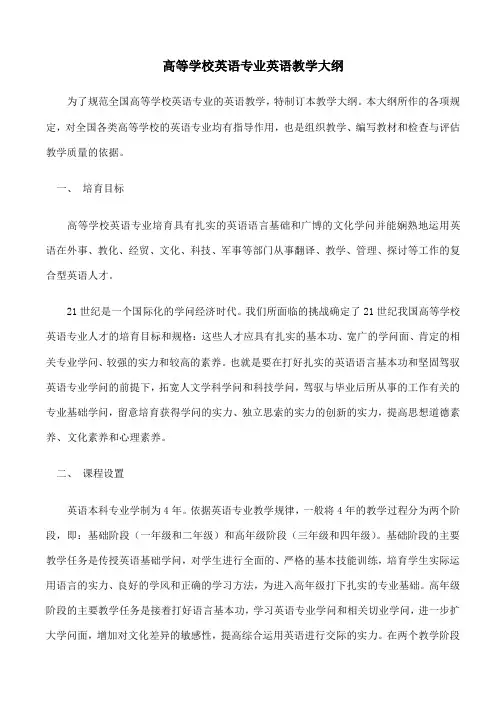
高等学校英语专业英语教学大纲为了规范全国高等学校英语专业的英语教学,特制订本教学大纲。
本大纲所作的各项规定,对全国各类高等学校的英语专业均有指导作用,也是组织教学、编写教材和检查与评估教学质量的依据。
一、培育目标高等学校英语专业培育具有扎实的英语语言基础和广博的文化学问并能娴熟地运用英语在外事、教化、经贸、文化、科技、军事等部门从事翻译、教学、管理、探讨等工作的复合型英语人才。
21世纪是一个国际化的学问经济时代。
我们所面临的挑战确定了21世纪我国高等学校英语专业人才的培育目标和规格:这些人才应具有扎实的基本功、宽广的学问面、肯定的相关专业学问、较强的实力和较高的素养。
也就是要在打好扎实的英语语言基本功和坚固驾驭英语专业学问的前提下,拓宽人文学科学问和科技学问,驾驭与毕业后所从事的工作有关的专业基础学问,留意培育获得学问的实力、独立思索的实力的创新的实力,提高思想道德素养、文化素养和心理素养。
二、课程设置英语本科专业学制为4年。
依据英语专业教学规律,一般将4年的教学过程分为两个阶段,即:基础阶段(一年级和二年级)和高年级阶段(三年级和四年级)。
基础阶段的主要教学任务是传授英语基础学问,对学生进行全面的、严格的基本技能训练,培育学生实际运用语言的实力、良好的学风和正确的学习方法,为进入高年级打下扎实的专业基础。
高年级阶段的主要教学任务是接着打好语言基本功,学习英语专业学问和相关切业学问,进一步扩大学问面,增加对文化差异的敏感性,提高综合运用英语进行交际的实力。
在两个教学阶段中课程的支配可以有所侧重,但应将4年的教学过程视为一个整体,自始至终留意打好英语语言基本功。
英语专业课程分为英语专业技能、英语专业学问和相关专业学问三种类型,一般均应以英语为教学语言。
三种类型的课程如下:(1)英语专业技能课程:指综合训练课程和各种英语技能的单项训练课程,如:基础英语、听力、口语、阅读、写作、口译、笔译等课程。
(2)英语专业学问课程:指英语语言、文学、文化方面的课程,如:英语语言学、英语词汇学、英语语法学、英语文体学、英美文学、英美社会与文化、西方文化等课程。
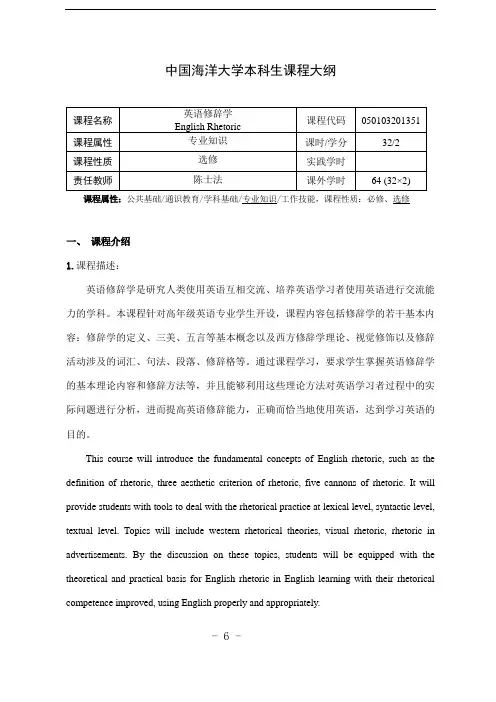
中国海洋大学本科生课程大纲课程属性:公共基础/通识教育/学科基础/专业知识/工作技能,课程性质:必修、选修一、课程介绍1.课程描述:英语修辞学是研究人类使用英语互相交流、培养英语学习者使用英语进行交流能力的学科。
本课程针对高年级英语专业学生开设,课程内容包括修辞学的若干基本内容:修辞学的定义、三美、五言等基本概念以及西方修辞学理论、视觉修饰以及修辞活动涉及的词汇、句法、段落、修辞格等。
通过课程学习,要求学生掌握英语修辞学的基本理论内容和修辞方法等,并且能够利用这些理论方法对英语学习者过程中的实际问题进行分析,进而提高英语修辞能力,正确而恰当地使用英语,达到学习英语的目的。
This course will introduce the fundamental concepts of English rhetoric, such as the definition of rhetoric, three aesthetic criterion of rhetoric, five cannons of rhetoric. It will provide students with tools to deal with the rhetorical practice at lexical level, syntactic level, textual level. Topics will include western rhetorical theories, visual rhetoric, rhetoric in advertisements. By the discussion on these topics, students will be equipped with the theoretical and practical basis for English rhetoric in English learning with their rhetorical competence improved, using English properly and appropriately.- 6 -2.设计思路:本课程引导高年级英语专业学生通过修辞学来探讨和理解由实际问题所驱动的修辞在理论和应用两方面的发展途径。
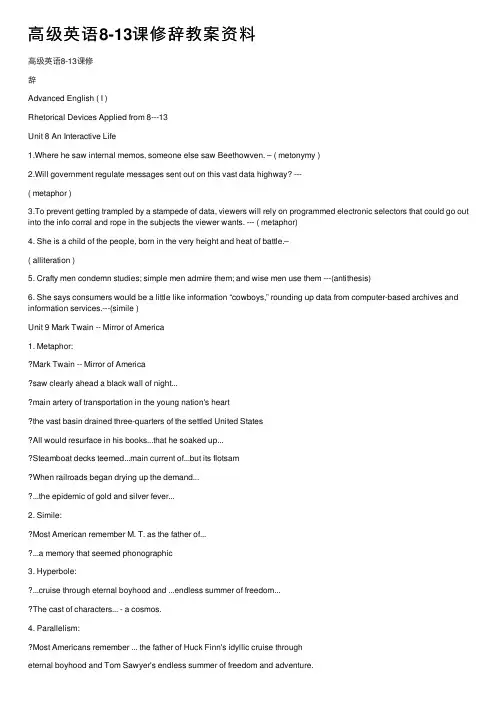
⾼级英语8-13课修辞教案资料⾼级英语8-13课修辞Advanced English ( I )Rhetorical Devices Applied from 8---13Unit 8 An Interactive Life1.Where he saw internal memos, someone else saw Beethowven. – ( metonymy )2.Will government regulate messages sent out on this vast data highway? ---( metaphor )3.To prevent getting trampled by a stampede of data, viewers will rely on programmed electronic selectors that could go out into the info corral and rope in the subjects the viewer wants. --- ( metaphor)4. She is a child of the people, born in the very height and heat of battle.–( alliteration )5. Crafty men condemn studies; simple men admire them; and wise men use them ---(antithesis)6. She says consumers would be a little like information “cowboys,” rounding up data from computer-based archives and information services.---(simile )Unit 9 Mark Twain -- Mirror of America1. Metaphor:Mark Twain -- Mirror of Americasaw clearly ahead a black wall of night...main artery of transportation in the young nation's heartthe vast basin drained three-quarters of the settled United StatesAll would resurface in his books...that he soaked up...Steamboat decks teemed...main current of...but its flotsamWhen railroads began drying up the demand......the epidemic of gold and silver fever...2. Simile:Most American remember M. T. as the father of......a memory that seemed phonographic3. Hyperbole:...cruise through eternal boyhood and ...endless summer of freedom...The cast of characters... - a cosmos.4. Parallelism:Most Americans remember ... the father of Huck Finn's idyllic cruise througheternal boyhood and Tom Sawyer's endless summer of freedom and adventure.5. Personification:life dealt him profound personal tragedies...the river had acquainted him with ......to literature's enduring gratitude......an entry that will determine his course forever...The grave world smiles as usual...Bitterness fed on the man...America laughed with him.Personal tragedy haunted his entire life.6. Antithesis:...between what people claim to be and what they really are......took unholy verbal shots at the Holy Land......a world which will lament them a day and forget them forever7. Euphemism:...men's final release from earthly struggleHe tired soldiering for two weeks with a motley band of Confederate guerrillas who diligently avoided contact with the enemy.8. Alliteration:...the slow, sleepy, sluggish-brained sloths stayed at home...with a dash and daring......a recklessness of cost or consequences...9. Metonymy:...his pen would prove mightier than his pickaxeUnit 10 The trial that rock the world.1.The trial that rock the world. --- (hyperbole)2.Darrow had whispered throwing a reassuring arm round my shoulder. ---( transferred epithet )3.H. L. Menken wrote sulphurous dispatches sitting in his pants with a fan blowing on him, and there was talk of running him out of town for….( transferredepithet )4.“The Christian believes that man came from above. The evolutionist believes that he must have come from below.” ---( antithesis )5.By the time the trial began on July 10, our town of 1500 people had taken on a circus atmosphere. --- ( metaphor)6.…that my case would snowball into one of the most famous trials in US. History.--- (metaphor)7.…until we are marching backwards to the glorious age of the sixteenthcentury …( irony)8.Dudley Field Malone called my conviction a “victorious defeat”.--- ( oxymoron)9.The case had erupted round my head not long after I arrived in Dayton as sciencemaster and football coach at the secondary school. --- ( synecdoche)10.Darrow walked slowly round the baking court. -- .( transferred epithet )11.One shop announced: Darwin is right – inside. – ( pun )Unit 11 But What's a Dictionary For?Personification1. The storm of abuse in the popular press that greeted the appearance of Webster?s Third New International Dictionary is a curious phenomenon.2. An article in the Atlantic viewed it as a “disappointment,”a “shock ,” a “calamity,” “a scandal and a disaster.” The Yew York Times, in a special editorial, felt that the work would…3. The Journal of the American Bar Association saw the publication as ...Alliteration4. --a concept of how things get written that throws very little light on Lincoln but a great deal on Life.Assonance5. The difference, for example, between the much-touted Second International (1934) and the much-clouted Third International (1961) is not like the difference between yearly models but…Synecdoche6. What of those sheets and jets of air that are now being used, in place of old-fashioned oak and hinges, to screen entrances and exist?7. But neither his vanity nor his purse is any concern of the dictionary’sMetonymy8. The Washington Post, in an editorial captioned "keep Your Old Webster's,” says, in the first sentence, …9. In short, all of these publications are written in the language that the 3rd International describes, even the very editorials which scorn it.Unit 12 The LoonsHyperbole1. …dresses that were always miles too long.2. …those voices belonged to a world separated by aeons from our neat world Metaphor3. …the filigree of the spruce trees4. …daughter of the forest5. I tried another line6. A streak of amberTransferred epithet7. All around, the spruce trees grew tall and close-set, branches blackly sharp against the sky which was lightened by a cold flickering of stars.8. I was ashamed, ashamed of my own timidity, the frightened tendency to look the other way.9. My brother, Roderick, who had not been born when we were here last summer, sat on the car rug in the sunshine and examined a brown spruce core, meticulously turning it round and round in his small and curious hands.Metonymy10. Those voices belonged to a world separated by aeons from our neat world of summer cottages and the lighted lamps of home. ( our modern civilization) Synecdoche11. the damn bone’s flared up againPersonification12. The two grey squirrels were still there, gossiping at us from the tall spruce beside the cottage,13. The news that somehow had not found its way into letters….Unit 13 Britannia Rues the WavesMetaphor:1.….the British fleet risks being elbowed out….2. Yet shipping is the essential lifeline for the nation’s economy.3. ….are bent on taking over the lion’s share….4. To cash in on the container revolution, you need….5.The one area which has weathered the economic storms….6.But P&O has no intention of throwing in the towel.。
文体修辞学、基本信息二、课程描述〃文体修辞学〃是一门英语专业高年级的专业选修课程,是一门在理论指导下实践性非常强的课程。
通过梳理文体学和宏观修辞学的关系,从语言学的视角找到一条进行文体(特别是文学文体)赏析的有效途径。
〃文体修辞学〃可以为语言学的学习奠定基础。
三、教学目标通过本课程的理论教学和相关实验训练,使学生具备如下能力:1、培养学生语言使用中的文体意识和修辞意识,使学生具备综合运用相关理论进行文体修辞应用的能力。
2、通过系统的文体修辞手法(含修辞格)的梳理,对大量的语言实例进行文体分析和批判,并通过一定量的练习,使学生具备修辞分析能力和语言运用能力。
四、课程目标对毕业要求的支撑五、教学内容第1章Introduction (支撑课程目标1)重点内容:现代文体学的定义、理论假说难点内容:现代文体学主要的理论假说教学内容:现代文体学的定义、理论假说、文体分析的目的、组成部分、步骤和性质第2 章Three Views on Style (支撑课程目标1、2、3)重点内容:文体是偏移的观点难点内容:文体是突出的观点教学内容:文体是变异的观点、文体是选择的观点和文体是突出的观点第3章Surface-structure Deviation (支撑课程目标1、2、3)重点内容:句法偏移、词汇偏移难点内容:句法偏移教学内容:音位偏移、句法偏移和词汇偏移等第4章Deep-structure Deviation (支撑课程目标1、2、3)重点内容:隐喻、反讽等修辞手法难点内容:各类修辞手法的应用教学内容:典型修辞手法的定义、分类和应用第5章Phonological Overregularity (支撑课程目标1、2、3)重点内容:音位层面过度规则化难点内容:韵律教学内容:音位层面过度规则化的分类和实例分析第6章Syntactic Overregulartity (支撑课程目标1、2、3)重点内容:排比难点内容:重复的分类及实例分析教学内容:句法层面过度规则化的分类和实例分析六、教学安排该课程每周2学时,16周,32学时为课堂授课教学时间。
英语短篇小说赏析教学大纲与教学计划英美短篇小说赏析是一门专业素质教育任选课,供英语专业高年级学生选读。
通过阅读和分析英语小说,促进学生语言基本功和人文素养的提高,增强学生对英语文学和西方文化的了解。
David LIN – Associate Prof, Master of ARTS 2014/2/23目录Course Introduction (1)Course Objectives (1)Course Related Information: (1)Teaching Schedule: (2)Recommended Text Book (3)Assessment Summary (3)Assessments (7)Assessment 1. Contrast Two Short Stories (7)Stories Analysis Worksheet (8)Marking Guide (9)Assessment 2 Read, study and analyse short Stories (10)Assessment 3. Story Writing (14)Course IntroductionA short story is usually a brief fictional narrative in prose concentrated on a single effect, for example, the creation of mood rather than the telling of a story, which is conveyed in a single significant episode or scene and involving a limited number of characters, sometimes even only one, with words of 3000 to 20000 in general. Whether long or short, a work of fiction is usually made up of certain identifiable devices or elements, each of which contributes to the making of an integrated and unified whole. In relation to the major elements of fiction, we generally refer to plot, character, setting, point of view, theme, style, tone, symbolism and allegory.This course is designed to introduce these fundamental elements to the students who major in English Literature in detail with illustrative readings provided so that they may be better able to analyse, understand and appreciate what they are reading.Course Objectives-Apply Fiction approaches to contrast two different short stories. The approaches may include but not limited to: plot, characters, setting, point of view, theme, style, tone, symbolism, and allegory.-Apply Fiction approaches to analyse a short story.-Write a short story (a slice of life) applying the approaches.Course Related Information:Course Code 41070103 Course Name: Appreciation of English Short Stories Credits 1.5 Teaching Hours 24Major English Course Feature ElectiveRevised Feb 2014Teaching Schedule:Week ContentFiction StudiesHome Readings Title Author(s)1 Plot The Bride Comes to Yellow Sky Stephen Crane Christmas Day in the morning (Pearl S. Buck)2 Characters Two Kinds Amy Tam The Catbird Seat (James Thurber)3 Setting To Build a Fire Jack London A Horseman in the Sky (Ambrose Bierce)4 Point of view A Clean, Well-lighted Place Ernest Hemingway The Broken Globe (Henry Kreisel)5 Theme Yellow Woman Leslie Silko Rain (W. Somerset Maugham)6 Assessment 1: Contrast two short stories from the home readings by analysing plot, characters, settings, point of view and themes. 30%7 Style My Oedipus Complex Frank O’Connor Haircut (Ring Lardner)8 Tone The Horse Dealer’s Daughter D. H. Lawrence Luck (Mark Twain)9 Assessment 2. Analysing Mark Twain’s story – Luck. Write an analysis essay discussing the story’s plot characters, setting, point of view,theme, style and tone. Word limit: 1200 (30%)10 Symbolism The Chrysanthemums John Steinbeck The Egg (Sherwood Anderson)11 Allegory Old Rogaum and his Theresa Theodore Dreiser Everything that Rises must converge (F. O’Connor)12 Assessment 3. Write a short story based on your own slice of life, applying the fiction approaches of plot characters, setting, point ofview, theme, style, tone, symbolism, and allegory. Length: two pages of A4 size, 40%2Recommended Text BookLiuchen, LIN (2009) An Approach to Fiction (2nd Edition), Shanghai: Shanghai Foreign Language Education PressAssessment SummaryOne作业号:311632Contrast two short stories in analysing fiveapproaches: plot, characters, settings,point of view, and themes.Complete the worksheet in no less than1000 words30% Week 64月4日23:59Two作业号:311636Analyse one given short story, and write anessay discuss about plot, characters,setting, point of view, themes, style, andtone.Word limit: 120030% Week 94月25日23:59Three作业号:311638Write your own short story (slice of yourlife), applying the fiction approach by plot,characters, setting, point of view, themes,style, tone, symbolism, and allegory.Use MS Word processor to complete yourdescriptive writing. Your work should be noless than two A4 size pages, using the fontof Time and New Roman in font size of 12,by 1.5 spacing line.40% Week125月16日23:59All the assessments must be uploaded online. First, student has to sign-up online.Click here to sign upTo sign up you must provide true information, your real Chinese name, real student ID and select institute name and your cell-phone number. 注意,在注册时,学生一定要提供真实信息。
《英语修辞学》课程教学大纲一、课程基本信息1.课程编号:325025062.课程名称:英语修辞学3.英文名称:English Rhetoric4. 课程简介:《英语修辞学》是为英语专业本科高年级开设的一门专业选修课,适用于英语专业教师教育方向和应用翻译方向,于第五学期开设,主要讲授英语修辞的基本原理及其应用,以及各类英语文体的语言风格特征,旨在引导学习者全面认识英语的语体特征、文体风格及其修辞要求和技巧,从本质上了解英语语体,掌握各类文体的修辞手段和语言特点,熟悉各种修辞手法,各类英语的功能,掌握语言使用中的“常规”和变异及其在各种文体中所表现出的规律,提高语言使用中的修辞与文体意识,使学习者具备一定的文学批评和对各类文体的分析和鉴赏水平。二、课程说明1.教学目的和要求:通过本课程的学习,使学习者较系统地了解英语修辞产生的原因及其对提高语言表现力的重要作用认识,增强对英语的理解能力,提高恰当运用英语语言的交际能力。学会从修辞的观点出发,从英语语言现象入手,对其内涵进行分析,初步掌握对各类文体的语言进行研究、分析和比较的方法。掌握各种主要的修辞手段,提高实践中运用英语的能力和理解与欣赏英语文体的能力。2.与相关课程衔接:先修课程:《英语国家概况》、《基础英语》、《英语听说》、《英语阅读》、《英语写作》、《英语语法》、《英国文学》等专业必修课,以及《英语词汇学》、《西方文化入门》等选修课。并修课程:《高级英语》、《英语语言学》、《英国文学》后续课程:《美国文学》、《学术论文写作》等必修课,《笔译1》、《笔译2》、《口译1》、《口译2》、《实用文体翻译》等专业方向课程,以及《跨文化交际》、《商务英语翻译》、《经贸口译》、《会展口译》、《计算机辅助翻译》等选修课程。3.学时:本课程周学时为2,共开16周,讲授学时32,总学时32,共计2学分。4.开课学期:本课程于第五学期开设5.教学方法:以教师为主导、学生为中心。在教师指导下,发挥学生的学习主动性。课堂讲授与分析讨论相结合。本课程将采取课堂教学和课后研究相结合的方法。课堂上教师致力于讲清楚基本概念,课后注重学生实践能力的提高。通过小组讨论、个人探究、书面报告、调研计划等具体活动来发现问题、探究解决问题的方法,培养学生解决语言方面问题的能力。6.考核方式:本课程的考核方式,建议以闭卷笔试为主,性质为考查。课程总成绩的评定,均应符合学校相关基本要求,由平时考核和期末考试两部分组成,平时成绩占40%,期末考试占60%。平时成绩根据考勤、平时作业(或课程小论文)和课堂提问和课堂讨论表现情况为考核依据。7.教材:推荐教材:张秀国主编《英语修辞学English Rhetoric》清华大学出版社、北京交通大学出版社,2005. 8.教学参考资料:1.徐有志. 现代英语文体学[M].郑州:河南大学出版社,2005.2.冯翠华. 英语修辞大全[M]. 北京:外语教学与研究出版社,1995.3.黄 任. 英语修辞与写作[M]. 上海:上海外语教育出版社,1996.4. 张德禄,张国. 英语文体学教程[M].北京:高等教育出版社,2008.5.胡曙中.现代英语修辞学[M]..上海:上海外语教育出版社,2004.6.覃先美,李阳. 英语修辞学概论[M]. 长沙:湖南师范大学出版社,2006.7.钱媛. 实用英语文体学[M].北京:外语教学与研究出版社,2006.8.李国南. 辞格与词汇[M].. 上海:上海外语教育出版社,2001.9.李诗平,蒋坚松. 英语修辞手册[M].. 长沙:湖南人民出版社,1998.10.李鑫华. 英语修辞格详论[M]. 上海:上海外语教育出版社,2000.11.吕熙. 实用英语修辞[M]. 北京:清华大学出版社,2004.12.王玉龙. 英语修辞学[M]. 北京:国防工业出版社,2006.13.王守元. 英语文体学要略[M]. 济南:山东大学出版社,2000.14.文军. 英语修辞格词典[M]. 重庆:重庆大学出版社,1992.15.Leech, Geoffrey N. 英诗学习指南:语言学的分析方法[M],外语教学与研究出版社,2001.16.Elena Semino & Mick Short. Corpus Stylistics: Speech, Writing and Thought Presentation in a Corpus of English Writing. London: Routledge. 2004.三、课程内容与教学要求第一章 概述教学目标:1)学习修辞学定义、修辞学研究的对象与方法及意义2)了解修辞与演说之间的关系3)了解修辞原则以及修辞学与其他学科的关系教学重点:修辞学研究的范围与任务;修辞的定义教学难点:修辞的定义授课时数:2教学内容:1) Rhetoric and oratory 2) Connotation of rhetoric 3) Definitions of rhetoric 4) Significance of Learning Rhetoric 第二章 西方修辞学的发展教学目标:1)了解西方修辞学产生与发展的历史2)了解亚里士多德等学者对西方修辞学的贡献3)了解当今修辞学发展的现状和主要趋势教学重点:亚里士多德等学者对西方修辞学的贡献;当代修辞学研究流派及发展趋势教学难点:当代修辞学研究流派及发展趋势授课时数:2教学内容:1) Classical rhetoric (5th c. B.C.---5th c. A.D.)2) Rhetoric in the Middle Ages (5th---14th c.)3) Rhetoric in the Renaissance (15th---16th c.) 4) New Classical Rhetoric (17th---19th c.)5) Contemporary Rhetoric(Modern Stylistics)第三章 词汇的文体与修辞功能教学目标:1)了解词的本义与衍生义2)了解概括词与特指词的语用功能3)了解抽象词和具体词的语用功能4)了解大词和小词的来源和对语体色彩的影响教学重点:词汇的选择及修辞意义教学难点:词汇的文体与修辞功能授课时数:2教学内容:1) Significance of using the suitable words 2) Denotation and connotation 3) Categories of words4) Rhetorical functions of words第四章 句子结构与变异及其文体与修辞功能教学目标:1)了解句子的分类、修辞上的句式多样化2)掌握不同句子结构的修辞作用和语用功能教学重点:不同句子结构的修辞作用教学难点:不同句式的语用功能授课时数:2教学内容:1) Principles of sentence rhetoric2) Sentence variety3) Types of sentences & rhetorical effects第五章 语音层面的修辞格教学目标:1)了解语音在语言中的地位,介绍语音学方面的知识,重点提示音韵法在诗歌中所起的重要作用及其对散文、广告等各语体的影响。2)理解并掌握各种音韵修辞现象识别和运用。教学重点:1)元韵、辅韵、头韵、尾韵、拟声等辞格的具体运用2)双关的概念及具体应用教学难点:双关的语用功能授课时数:2教学内容:1)Alliteration2)Assonance 3)Consonance 4)Onomatopoeia 5)Aposiopesis 6)Apostrophe 7)Pun第六章 句法结构层面的修辞格教学目标:1)了解句法结构层面的各修辞格的定义、结构形式及语用功能。2)了解以反复辞格为重点的各个辞格在语言表达中的重要作用和多种表现形式。3)比较和鉴别各个修辞手法的变化。教学重点:1)反复、排比、对照等句法辞格的概念和具体应用;以反复辞格为讲述重点,说明其在语言表达中的重要作用和多种表现形式。2)Syllepsis和Zeugma的修辞对比教学难点:变式与常式之间的比较和鉴别授课时数:2教学内容:1) Repetition 2) Parallelism3) Antithesis4) Climax 5) Anticlimax 6) Syllepsis7) Zeugma8) Chiasmus 9) Rhetorical Question第七章 语义层面的修辞格教学目标:1)了解比喻的研究、比喻的基础与要素、明喻的概念、形式。2)理解隐喻的定义、隐喻的使用、分类、表现形式、语义结构及翻译方法、明喻与隐喻的异同。3)了解借代的定义与特点、借代的语用类型和翻译方法,借代、提喻与隐喻的区别、换称的定义、换称的渊源。教学重点:1)明喻、隐喻、拟人、移就等的概念和具体应用;以隐喻为重点。理清概念,基本分清相邻辞格间的相似和相异之处。